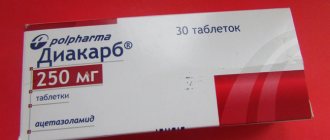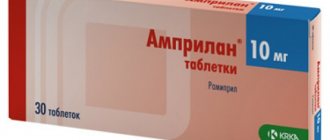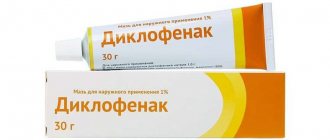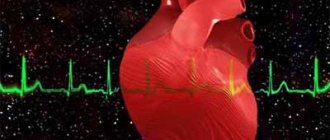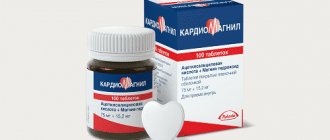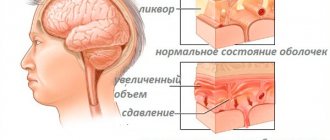- January 4, 2020
- Other drugs
- Fedor Bunin
Neurologists often prescribe Diacarb to their patients along with anticonvulsants. The instructions for use recommend its use for glaucoma, mountain sickness, and epilepsy. Thanks to its pronounced diuretic effect, the medicine helps remove excess fluid from the body, reducing swelling and normalizing intracranial pressure. What other indications for use exist, in which cases is it better to refuse the drug, what do patients say after using it - we will dwell on these issues in more detail in the article. We will also tell you about the dosage regimen for patients of different age categories.
Description of the drug: composition and release form
The instructions for use characterize "Diacarb" as a diuretic drug. It causes a strong diuretic effect, therefore it is used for edema of various origins. It can be used by adults and children over 3 years old. However, in some cases, doctors prescribe the medicine to children under this age. There are also restrictions for some adults due to the high risk of side effects.
The drug is available in the form of white, convex tablets. They are packed in blisters and cardboard boxes. The active ingredient is acetazolamide. Its content in each Diacarb tablet is 250 mg. As auxiliary components, povidone, E572, aerosil, MCC, croscarmellose sodium should be noted. Sometimes you can find a different composition. In addition to the active ingredient, each tablet contains potato starch, talc and sodium starch glycolate.
Both excipient options are absolutely safe and approved for use. Due to the absence of a component, the manufacturer may choose another set of additional components. Both options do not differ in the severity of the therapeutic effect. Therefore, you can choose any one for treatment.
The only reason why it is necessary to know the composition is if the patient has an allergy or a tendency to do so. In this case, you should choose the option to which there is no specific reaction. If an allergy appears after the first use, it is better to purchase a drug with a different set of excipients.
Are there other drugs with similar properties?
Acetazolamide-based drugs may be sold in pharmacies under other brand names. They are complete analogues of Diacarb and are no different in application. Carbonic anhydrase blockers are:
- Diuremide.
- Diamox,
- Diazomide,
- Diluran,
- Glaupax.
Diacarb has a proven therapeutic effect for various neurological and general diseases. Application requires control using laboratory indicators and knowledge of the characteristics of the action.
Pharmacological features
What do Diacarb tablets help with? According to the instructions, the drug has the following therapeutic properties:
- diuretic;
- antiglaucoma;
- antiepileptics;
- help reduce intracranial pressure.
When compared with other diuretic drugs, the diuretic effect of Diacarb is weaker. When fluid is removed from the body, a large number of potassium ions are removed along with it. It is for this reason that during treatment, patients are additionally prescribed medications that enrich the body with potassium and magnesium (for example, Panangin, Asparkam).
In a smaller volume, compared with potassium ions, phosphates, calcium and magnesium ions are washed out of the body. To avoid the development of metabolic disorders, it is necessary to replenish the losses of relevant microelements. This recommendation applies to cases where the course of treatment lasts 2 weeks or more.
The mechanism of action of the drug is such that after 3 days it loses its diuretic effect. Therefore, using it to remove excess fluid for longer than this period is considered inappropriate. However, if 2 days after you start taking it you take a short break for 1-3 days, the medication again begins to have a diuretic effect. As a result, you need to take Diacarb not continuously, but with short breaks.
Diuretic is not the only effect that is stated in the instructions. The drug also has an antiglaucoma effect. After its use, the production of moisture in the anterior chamber of the eye decreases, and intraocular pressure decreases.
Diacarb also reduces the amount of fluid produced in the cerebral ventricles and cerebrospinal fluid. This helps normalize intracranial pressure and the dynamics of cerebral cerebrospinal fluid. Therefore, the medicine is often prescribed to patients in the complex treatment of various disorders caused by increased intracranial pressure.
The antiepileptic effect is achieved due to the fact that the drug stops foci of pathological excitability in the structures of the brain.
In addition to the above therapeutic properties, side effects of the drug are often used in practice, namely the ability to cause metabolic acidosis. It eliminates respiratory disorders, including sleep apnea.
Mechanism of action
Acetazolamide is classified as a weak diuretic. The point of action is the enzyme carbonic anhydrase. With its chemical composition, it blocks the action of sodium and potassium absorption in the most peripheral ends of the tubules of the main functional unit of the kidneys - the nephron.
As a result, the excretion of electrolytes in the urine increases: sodium, potassium, bicarbonate salts, magnesium, calcium, phosphates while maintaining the chlorine content. A side effect is formed - hypokalemia and a decrease in magnesium levels, which can negatively affect the heart rate.
The lack of carbonic acid and bicarbonate salts leads to the fact that the acid-base reaction in the body shifts towards metabolic acidosis (increased acidity). It is this property that is important in the treatment of breathing disorders during sleep.
It should be borne in mind that after three days from the start of treatment, Diakarb loses its diuretic properties. A break of several days is necessary to restore carbonic anhydrase activity. Then the drug begins to “work” again as a diuretic.
Reduced carbonic anhydrase activity in brain tissue contributes to:
- reducing the production of cerebrospinal fluid in the ventricles, which is necessary for chronic intracranial hypertension and other liquorodynamic disorders;
- suppression of foci of excitation in the nuclei that cause epileptic attacks.
In neurological practice, Diacarb is considered a universal drug and is reasonably used to treat adults and children.
Indications for use
The drug is prescribed only after diagnostic measures have been carried out. The instructions for use for Diakarb establish the following indications for its use:
- edematous syndrome of mild or moderate severity (with cirrhosis of the liver, pulmonary vascular syndrome, circulatory failure);
- acute attacks of glaucoma;
- addition to prescribed antiepileptic therapy;
- increased intracranial pressure;
- secondary glaucoma;
- gout;
- Meniere's disease;
- premenstrual syndrome;
- altitude sickness.
In pediatric practice, the indications for use of the drug "Diacarb" are identical.
Diacarb tablets
The synthetic drug Diacarb belongs to the group of diuretics. The medicine has a strong diuretic effect and is used for edema of various natures. It is allowed to be used by adults and children over 3 years of age. However, for certain ailments, doctors may prescribe medication to a child under this age. For many categories of patients, the use of the drug is recommended with caution, since there is a risk of side effects.
Composition and release form
The drug is dispensed in the form of white tablets with a convex shape. The pills are packaged in blisters that are placed inside cardboard packs. You can view the composition of the tablet using the table:
| Active substance | Excipients |
| Acetazolamide (250 mg) | Microcrystalline cellulose |
| Povidone | |
| Croscarmellose sodium | |
| Magnesium stearate | |
| Colloidal silicon dioxide |
Pharmacodynamics and pharmacokinetics
Diacarb is an inhibitor of carbonic anhydrase, which is involved in the metabolism of carbonic acid. Inhibition of the enzyme helps reduce the rate of absorption of sodium and bicarbonate ions from urine into the blood. In pulmonary heart failure, the drug suppresses the activity of brain carbonic anhydrase. This effect helps reduce intracranial pressure and the formation of cerebrospinal fluid.
Metabolic disorders due to inhibition of ciliary body carbonic anhydrase contribute to the treatment of glaucoma. The active ingredient Diakarba normalizes outflow and reduces the secretion of aqueous humor. Tablets are widely used when sodium and water are retained inside the body, to prevent edema. The maximum concentration of acetazolamide in blood plasma is observed after oral administration after 2 hours. The drug is excreted through the kidneys after 1 day.
Indications for use
The drug can be prescribed by a doctor after conducting the necessary studies. Instructions for use establish the following indications for treatment with Diacarb:
- weak or moderate severity of edema syndrome (with cirrhosis of the liver, circulatory failure, edema associated with pulmonary vascular syndrome);
- the need for additional therapy to antiepileptic drugs;
- acute attacks of glaucoma, persistent cases of its course;
- increased intracranial pressure;
- secondary glaucoma;
- acute altitude sickness.
General recommendations for use
The tablets should be taken orally whole with plenty of water. There is no need to chew, crush or bite them.
If you miss a pill the next day, you cannot increase the dosage, trying to replenish the amount of the drug in the body. Such an approach will not only not have a pronounced therapeutic effect, on the contrary, it will weaken the diuretic effect. In addition, deviation from the recommended dosage regimen may cause unwanted side effects.
It is better to take the medicine in the morning or afternoon so that you can calmly empty your bladder and not suffer from frequent urges to urinate at night.
Scheme of application of "Diacarb" and "Asparkam"
Complex treatment of hypertension includes combinations of different groups of drugs with diuretics.
Diacarb is one of the most used medications in clinical practice, which belongs to the class of carbonic anhydrase inhibitors with a moderate effect. The drug is widely prescribed by neurologists, cardiologists and ophthalmologists. Accelerated removal of potassium ions from the blood is one of the undesirable consequences of taking the drug.
Replenishment of electrolyte reserves is carried out using anionic-cationic drugs, to which Asparkam belongs.
Acetazolamide (the active ingredient of Diacarba) is a derivative of sulfanilic acid, which blocks carbonic anhydrase, reducing the synthesis of sulfur dioxide and water. Pharmacodynamic effects of the drug:
- Improving renal blood flow - increases diuresis (diuretic effect) and removes potassium from the body (used to correct moderate hyperkalemia).
- Regulation of fluid production by the ciliary body reduces intraocular pressure in glaucoma.
- A decrease in the reabsorption of bicarbonates in the nephron tubules leads to the development of transient (transient) acidosis. The condition returns to normal 1-2 days after discontinuation of the drug.
- The accumulation of carbon dioxide in brain tissue reduces the excitability of neurons and prevents the development of pathological impulses. The effect is used to prevent epileptic seizures.
- Controlling the synthesis of cerebrospinal fluid in the ventricles of the brain - normalizes the level of intracranial pressure in intracranial hypertension.
Indications for the use of Diacarb in different areas are presented in the table.
Pathology Clinic
| Ophthalmological |
|
| Therapeutic |
|
| Neurological |
|
Features of the metabolism of the drug "Diacarba":
- absorbed into the cavity of the small intestine;
- degree of binding to blood proteins 70-90%;
- “target structures” whose tissues are rich in the enzyme carbonic anhydrase: kidneys, eyeball, red blood cells, central nervous system;
- excretion in urine, unchanged;
- 90% of the active substance is eliminated within 24 hours.
Undesirable consequences of taking the drug most often occur in the first stage of therapy (2-3 weeks). The main groups of side effects are presented in the table.
Category Symptoms
| |
| From the digestive tract |
|
| Neurological |
|
| Ophthalmological |
|
| From the genital organs |
|
| Excretory system |
|
The mechanism for the development of most side effects is associated with impaired potassium metabolism in the body. One method of preventing symptoms is to take electrolyte donor medications. For example, use the scheme - “Asparkam” with “Diacarb”.
The composition of Asparkam is aspartate salts of potassium (K+) and magnesium (Mg2+). The medicine is intended to regulate metabolic processes, mainly in the myocardium.
Aspartate transports ions into the cell, where they are involved in the process of muscle contraction at the molecular level.
The drug is prescribed for the correction of electrolyte disturbances (deficiency of potassium and magnesium in the body), the prevention of hypokalemia during treatment with loop diuretics.
Contraindications to the use of Asparkam:
- renal failure;
- hemolytic anemia;
- hyperkalemia;
- myasthenia gravis;
- AV conduction disturbance.
Patients with antacid gastritis experience dyspeptic symptoms, epigastric burning, nausea, and diarrhea.
Dosage regimens for adults
The use of the Diakarba complex with Asparkam implies compliance with the recommendations:
- absorption of the diuretic does not depend on food intake, so it is taken at any time of the day.
- a stable effect is observed when using a therapeutic dose once a day, or every other day.
The regimen for taking Diacarb and Asparkam by adults for various diseases is presented in the table.
Pathology "Diacarb" "Asparkam"
| Edema syndrome of cardiovascular origin | 250 mg (1 tablet) per day | 1 tablet 3 times a day (under the control of blood osmolarity 310-320 mOsm/l) |
| Open angle glaucoma | 250 mg 3-4 times a day | |
| Epilepsy | 8-30 mg/kg body weight/day (divided into 4 doses). Maximum daily dose – 1000 mg (4 tablets) | |
| Altitude sickness (to speed up acclimatization) | 500 mg 2 times a day. Prevention of symptoms - 2 days before getting up | |
| Headache (after traumatic brain injury) | 250 mg 2-3 times a day | |
| Periodic paralysis | 250 mg 4 times a day |
In cardiological practice, Diacarb is not prescribed together with Acetylsalicylic acid (Aspecard, Aspirin) due to the high risk of severe acidosis, lethargy, coma, and death.
Use in childhood
In pediatric practice, Diacarb is prescribed for the treatment of neurological diseases:
- hydrocephalus – accumulation of fluid due to increased synthesis of cerebrospinal fluid or impaired outflow;
- epilepsy with “small” seizures: partial (Jacksonian), myoclonus and absence seizures.
The most sensitive to the drug are disorders of liquor dynamics, which are accompanied by interstitial edema of the brain. This type of intracranial hypertension is caused by an increased content of Na+ ions and water in the periventricular (periventricular) white matter.
Clinical signs of pathology:
- Headache. Children complain of a feeling of “expansion”, “squeezing of the eyes.” Intensifies when tilting the head and coughing. The pain is most pronounced in the morning, immediately after waking up.
- Vomiting, after which the intensity of the symptom decreases.
- Congestion in the fundus is a pathognomonic (most specific) sign.
Conservative treatment of pathology involves:
- diet with limited salt intake;
- drinking regime (reducing the amount of fluid consumed);
- taking diuretics (Diacarba), glucocorticoids (in severe cases).
Surgical treatment is indicated if drug therapy is ineffective for 2 months. "Diacarb" for epilepsy in children is an auxiliary element for basic anticonvulsants.
Neurologists prescribe a combination of Diacarb and Asparkam once before routine vaccination (DPT, CPC, Imovax-Polio) in order to prevent complications in children at risk. Taking medications does not reduce the likelihood of developing seizures.
Parental complaints about prolonged crying, sleep disturbances, and increased excitability are not indications for taking the drug. To reduce nervous excitement in pediatric practice, Cinnarizine or Glycine is used.
How to take Asparkam and Diacarb correctly for children?
Prescription of medications in pediatric practice is carried out taking into account the child’s body weight. Doses and recommendations for taking Asparkam with Diacarb are presented in the table.
Pathologies Dosage calculation Special instructions
| Hydrocephalus |
| Take in the morning, once |
| Epileptic seizures |
|
|
Correction of the dose and regimen of anticonvulsants is carried out 2 times a year.
Long-term diuretic therapy requires periodic monitoring of blood pH and water and electrolyte balance. Taking Asparkam with Diacarb is recommended for laboratory-confirmed hypokalemia and hypomagnesemia.
conclusions
"Diacarb" is a drug that has a moderate diuretic effect, which gradually decreases with long-term use. The medication is prescribed as part of complex therapy for neurological and cardiovascular disorders.
In order to prevent water and electrolyte imbalance, it is recommended to use regimens that include Asparkam. The selection of an effective dose, regimen and duration of therapy is carried out by the attending physician. Before you start taking it, you should read the instructions.
Source: https://cardiograf.com/preparaty/prochie/diakarb-i-asparkam-skhema-priema-vzroslym.html
Dosage regimen
For treatment to be as effective as possible, the dosage regimen must be strictly followed. Instructions for use of Diakarb contain the following instructions:
- To relieve edema syndrome, patients are prescribed 250-375 mg of the drug per day. Admission is carried out once. Additionally, it is necessary to treat circulatory failure, limit salt intake, and prevent potassium ion deficiency.
- When treating open-angle glaucoma, the medication is taken once in a dosage of 250 mg. If the disease recurs, it is recommended to take a tablet of medication every 4 hours.
- Epilepsy is treated with a course of the drug for 3 days. The daily dosage is 250-500 mg. After the course a break is required.
Mechanism of operation and dosage
The active substance lowers blood pressure by removing excess fluid from the body through the kidneys and thereby relieving the load on the blood vessels. The study showed that Diacarb tablets are effective not only for the treatment of arterial hypertension, but also for relieving glaucomatous spasms. The medicine begins to act 24 hours after administration. The official instructions for use state that you need to take one tablet once a day, taking daily breaks. This method will help avoid dehydration. During the therapeutic course, it is recommended to avoid salt and additionally take potassium-containing foods or vitamin complexes.
"Diacarb" is prohibited during pregnancy and breastfeeding, and is not recommended for children and elderly patients.
Use during pregnancy
There have been no scientific clinical studies regarding the use of Diacarb during pregnancy. Due to the high risk of negative effects on the fetus, it is prohibited to use it in the first trimester. If there is a need to use it at a later date, it is recommended to do this under the constant supervision of a doctor. Therapy is prescribed when the potential risks to the development of the fetus are lower than the benefits directly to the mother.
The active ingredient of the drug has a high toxic effect and is excreted together with milk. Therefore, when treating with Diacarb, it is better to stop breastfeeding.
Analogs
To replace Diacarb, synonymous drugs are often used that have a composition similar to the original, pharmacological action, lists of indications and contraindications:
- Acetazolamide;
- Diazomide;
- Diuremide.
The most inexpensive analogues of a diuretic that can compensate for its absence include Veroshpiron, Furosemide, Dichlorothiazide. Such medications often cost several times less than the original product, but do not always achieve the same pronounced therapeutic result.
It is necessary to take into account an important point - independent replacement of Diacarb tablets with any analogue is unacceptable. Hydrocephalus is a serious and dangerous disease, the treatment of which must be carried out under the supervision of a specialist, using medications prescribed by a doctor.
Use in pediatrics
Due to the drug’s ability to regulate the amount of cerebrospinal fluid, it is prescribed to children with hypertensive-hydrocephalic syndrome and hydrocephalus. Why else are Diacarb tablets prescribed to minors? Epilepsy and glaucoma are also indicated.
Treatment should be carried out in a hospital setting and under the supervision of a doctor. The dosage regimen is selected individually in each specific case. In this case, the doctor must take into account the age of the potential patient, his disease and the developmental characteristics of the body. The instructions provide for a minimum daily dosage of 50 mg.
The medicine is also prescribed to newborns. In this case, indications for use are: skull enlargement, suture dehiscence, epilepsy. The course of therapy can take place both in inpatient and outpatient settings, but always under the supervision of doctors. For newborns, it is important to correctly select the daily dosage of Diacarb to avoid the development of side effects. The course of treatment is no more than 5 days. After this, it is necessary to conduct a comprehensive diagnosis to assess the dynamics of recovery.
Reviews
Reviews for Diakarb are quite contradictory. Some mothers praise the drug, write in blogs about how well it helped their babies, that after it they began to sleep better and more peacefully, and finally began to smile at them. Others, on the contrary, scold.
Ksenia Diakarb was prescribed after intracranial pressure was diagnosed in a premature baby at 1 month. We doubted for a long time whether to give it or not; we visited several doctors. On the other hand, we heard a lot of scary stories about what happens to children if ICP is not treated before the age of 1 year, so it was decided to take the drug carefully under the supervision of a doctor according to a gentle regimen. There is an effect from the treatment, but there were also side effects such as shortness of breath, tremors, and blue hands. At the end of the course, the side effects went away.
Maria Diakarb is a serious medicine, but very effective. My child was able to develop normally only thanks to this drug. The main thing is to find a good neurologist who can choose the right dosage, so if in doubt, it is better to go to several specialists. It is important to complete the course of treatment on time - up to 1 year! The sooner you start, the better the result.
Diacarb is a good medicine, but many parents are afraid to use it because of the large number of side effects. In such a situation, we can only advise them to see another doctor who specializes in the disease of their infant. If he prescribes him the same drug and in the same dosage as the first one, then he can safely use it. However, the condition of the baby while taking the medicine still needs to be carefully monitored. If there are any changes in his behavior or well-being, you should report this to your doctor.
special instructions
If the patient has a hypersensitivity to the components of the drug, dangerous consequences may occur. If adverse reactions occur, you should stop taking it and consult a doctor. Exceeding the prescribed dosage does not enhance the diuretic effect, and in some cases may even reduce it altogether. The medicine can also provoke acidosis. Therefore, in case of pulmonary emphysema and embolism, it should be used with caution.
Diacarb for diabetes increases the risk of hyperglycemia in patients. For this disease, its use in therapeutic practice is not recommended. In high doses, the medication can cause drowsiness, fatigue, dizziness and spatial disorientation. Therefore, throughout the entire course of treatment, it is better to refrain from driving vehicles and work that requires increased concentration and quick reaction.
Diacarb at pressure
To normalize high intraocular pressure, the drug Diacarb is prescribed. The diuretic is widely used in ophthalmology to relieve swelling of the optic nerves and eliminate the painful syndromes caused by it, accompanied by deterioration of the image and headaches. The medication is recommended for glaucoma and ocular hypertension.
Composition and form
The diuretic "Diakarb" contains 250 mg of acetazolamide as the main active ingredient. Release form: white, flat, round, odorless tablets. They are sold in a cardboard box, where in addition to the pharmaceutical product there is an official summary containing a detailed description of the medicine. The tablets are packaged in blisters of 12 pieces.
Mechanism of operation and dosage
The active substance lowers blood pressure by removing excess fluid from the body through the kidneys and thereby relieving the load on the blood vessels. The study showed that Diacarb tablets are effective not only for the treatment of arterial hypertension, but also for relieving glaucomatous spasms.
The medicine begins to act 24 hours after administration. The official instructions for use state that you need to take one tablet once a day, taking daily breaks. This method will help avoid dehydration.
During the therapeutic course, it is recommended to avoid salt and additionally take potassium-containing foods or vitamin complexes.
"Diacarb" is prohibited during pregnancy and breastfeeding, and is not recommended for children and elderly patients.
Indications for use
The drug can be used in addition to the main therapy for glaucoma for fluid outflow.
The pharmaceutical product acts as a decongestant and a mild, long-acting diuretic.
The range of uses is wide and includes ophthalmological ailments and diseases of the genitourinary system. The medicine is not used independently, but is prescribed as an element of combination therapy.
The medication has the following indications for use:
- relief of symptoms of epilepsy;
- neutralization of edema of various origins;
- removal of excess eye fluid in glaucoma.
Pharmacological group
"Diacarb" does not treat glaucoma and ocular hypertension, but helps relieve the negative symptoms that occur with increased intraocular pressure by removing excess fluid from the body and temporarily dilating blood vessels. This is a diuretic and not an ophthalmic topical medication. INN drugs are medicines containing the basic active ingredient acetazolamide.
Contraindications
Kidney disease is one of the contraindications to therapy with this drug.
The medication is not recommended for children and adults with low blood pressure, as well as chronic and acute kidney diseases, uremia.
Diabetics and people suffering from Addison's disease should not take a diuretic. An absolute prohibition for use is intolerance to the active substance. The medicine has the following contraindications:
- pregnancy and breastfeeding;
- chronic hypotension;
- diseases of the urinary system and kidneys;
- cardiovascular diseases;
- hypokalemia.
Side effects
Negative effects when taken in excess of a dose in adults are expressed in deterioration of vision and the occurrence of situational myopia, headaches, nausea and vomiting. If a patient develops individual intolerance to the main active ingredient or additional components of the drug, the following negative reactions occur:
- diarrhea;
- muscle spasms and cramps;
- hypokalemia;
- anorexia;
- skin redness, urticaria, itching;
- ringing in the ears and temporary loss of orientation in space;
- hematuria;
- nephrolithiasis.
If you need to change your medication, you should go to the doctor rather than do it yourself.
Side effects in adolescents are more pronounced, so it is recommended to use the product before the age of 18 carefully and under the supervision of a doctor. Self-medication is prohibited. If painful symptoms are detected, the drug is replaced with analogues that do not contain acetazolamide. The optimal substitute is selected by the doctor.
Compatibility
The drug requires additional approval from the doctor if the patient is taking other medications containing acetylsalicylic acid. Combination with ephedrine and muscle relaxants leads to intoxication of the body.
Parallel use with antiepileptic drugs causes leaching of minerals from the bones and serves as an impetus for subsequent osteomalacia. Taking other diuretics enhances and prolongs the diuretic effect, which can lead to hypokalemia and lead to kidney failure.
When using Diacarb, patients must follow a salt-free diet.
Drug overdose
Excessive accumulation of the drug in the body leads to negative reactions from the digestive, cardiovascular and urinary systems. The stronger the overdose, the more pronounced the side effects. Detox therapy is symptomatic: the patient needs to rinse the stomach and stop using the medication.
Release and storage
The temperature for storing the medicine should be within 25 degrees.
To purchase medicine in a pharmacy network, you need a corresponding doctor's prescription. The tablets must be stored in a place where children and pets cannot reach.
Storage temperature - no higher than 25 degrees Celsius, humidity - no more than 80%. The medication should be protected from direct sunlight. The sealed product is stored for 5 years.
It is prohibited to use expired medication, as it loses its healing properties and becomes dangerous to the body.
Analogues of the drug
If it is impossible to drink Diacarb due to allergic and adverse reactions, analogues of the medication are used. Anti-glaucoma eye drops, for example, Vidal, can be used as substitutes. The pharmaceutical drug Furosemide is recommended as a diuretic with an anti-edematous effect, injections of which are performed intramuscularly as prescribed by a doctor.
Source: https://VseDavlenie.ru/lekarstva/kombinirovannye/diakarb-pri-davlenii.html
Interaction with other drugs
The active ingredient Diacarba can react with other medications, reducing effectiveness and causing harm to health. For this reason, self-medication is unacceptable. When taking a medicine, it is important to pay attention to the features of its interaction:
- When used together with drugs characterized by antiepileptic activity, there is a risk of increased manifestations of osteomalacia.
- By interacting with diuretics, Diacarb enhances the diuretic effect.
- The dosage must be adjusted if the patient takes cardiac glycosides or drugs that increase blood pressure.
- The occurrence of metabolic acidosis and increased toxic effects on the central nervous system can occur when taking the drug simultaneously with acetylsalicylic acid.
- Combination with beta-blockers and cholinergic agents enhances the hypotensive effect on intraocular pressure.
The listed features are not the only ones. The attending physician should tell you in more detail about the restrictions and predisposition measures.
Drug interactions
An increase in effect is observed during joint therapy with Diacarb and certain groups of substances:
- folic acid antagonists;
- means to lower blood sugar levels;
- anticoagulants;
- cardiac glycosides;
- hypertensive drugs;
- with Aminophylline (increases the amount of daily urine);
- β-blockers.
Interaction with aspirin is not allowed due to toxic effects on the brain.
Ammonium chloride weakens the effect of the diuretic. Diacarb increases the concentration of muscle relaxants in the blood.
Possible contraindications
It is undesirable for some categories of people to take Diacarb. The following diseases and conditions are contraindications:
- uremia;
- hyponatremia;
- acute renal and liver failure;
- diabetes;
- metabolic acidosis;
- first trimester of pregnancy;
- Addison's disease;
- chronic decompensated angle-closure glaucoma;
- hypersensitivity to the components of the drug.
"Diacarb" is prescribed with caution for edema of hepatic/renal origin, in the 2nd and 3rd trimesters of pregnancy.
Diacarb for children
Self-prescription of a potent diuretic together with Asparkam is prohibited. Treatment is prescribed by a doctor based on the diagnosis of intracranial pressure.
The dose of these medications is calculated by a specialist, based on the age, weight of the baby, and the stage of the disease. The doctor monitors the behavioral state of the little patient and, looking at how the child tolerates the medicine, adjusts its dose.
If children experience epileptic seizures, the use of Diacarb is carried out according to this plan.
- Age from 4 to 12 months: use 50 mg of medication once a day.
- Age 2 - 3 years: prescribed 50 - 125 mg 1 time per day or divide the indicated dosage into 2 times.
- Ages 4 – 18 years: drink 125 – 250 mg 1 time per day in the morning.
Regardless of the average dose, for a child over 3 years old, the dose is calculated individually based on weight in the ratio of 8 – 30 mg tablets per 1 kg of child.
For glaucoma, the dose of the drug for children is calculated only by weight. The daily dose is divided into 2 to 4 times and the medicine is given to drink at equal intervals.
“Diacarb” and “Asparkam” are prescribed to infants when the baby is diagnosed with various brain disorders, as well as glaucoma and epilepsy.
A factor in such ailments is often an insufficient supply of oxygen to the baby’s brain during development in the womb. This condition can be caused by:
- problems with the umbilical cord;
- long-term maternal toxicosis;
- rapid aging of the placenta;
- difficulties during childbirth.
In such situations, increased production of cerebrospinal fluid occurs. It compresses the brain, thereby causing headaches in the baby. This causes the child to cry constantly and for a long time. He sleeps and eats poorly, his general health also deteriorates, and his development is inhibited.
Complete absorption of Diacarb occurs within 3 hours after consumption. 90% of the medication is excreted in the urine.
For newborns and children up to 6 months, they are prescribed to drink ¼ tablet of Diacarba in the morning on an empty stomach. The tablet must be crushed and diluted with water. Give the drug according to the prescribed regimen. Treatment is carried out for a month. When a diuretic is not used, you need to give Asparkam ¼ tablet in the morning and evening.
The drugs have a peculiar taste, so after taking them it is better to immediately give the baby breastfeeding or formula.
If the baby is more than 6 months old, the dose of Diacarb is increased to 1/3 of the tablet.
In case of acute potassium deficiency during medical therapy, Asparkam is prescribed to children intravenously.
When the drug has been administered for 5 days, a blood test is taken from the child and sent for re-examination to determine the effect of the drug on the baby. Long-term use of Diacarb can lead to a decrease in leukocytes in the circulatory system and the development of hemolytic anemia.
You can treat your child with Diacarb at home, but constant medical supervision is required. If the disease is severe, the drugs are used together with other medications in a hospital.
Due to the drug’s ability to regulate the amount of cerebrospinal fluid, Diacarb for children is prescribed for hypertensive-hydrocephalic syndrome and hydrocephalus. Indications for using the medicine to treat a child may include epilepsy and glaucoma. Treatment with the drug should be carried out in a hospital setting under the close supervision of specialists.
Newborns
A doctor may prescribe the drug to newborns for suture dehiscence or skull enlargement, or for the treatment of epilepsy. The medication should be taken in a hospital or at home under the supervision of a specialist. It is important to strictly follow the prescribed dosage to avoid side effects. The course of treatment is no more than 5 days, after which it is necessary to re-examine the baby to determine the dynamics of therapy.
Side effects
During treatment, it is important to follow the doctor's recommendations and strictly adhere to the prescribed dosage. Otherwise, there is a high probability of undesirable consequences. The instructions list the following side effects of Diacarb:
- From the side of the central nervous system: dizziness, disorientation in space, sensation of “goosebumps” on the skin, drowsiness, ataxia, hearing defects, photophobia, convulsions.
- From the gastrointestinal tract: nausea and vomiting, diarrhea, loss of appetite to the point of anorexia, taste disorders. Hepatic colic often appears, and fulminant necrosis develops.
- If the urinary system is damaged, there is a risk of nephrolithiasis, a change in the frequency of the urge to urinate.
- Long-term use of the medication can cause acidosis. Therefore, during the course of treatment it is important to regularly monitor the peripheral blood picture.
- From the hematopoietic system: thrombocytopenia, aplastic anemia, agranulocytosis, hemorrhagic diathesis.
- An allergic reaction can be expressed in the form of urticaria, skin itching, uncharacteristic rashes, and anaphylaxis.
- There may be an imbalance in the acid-base balance and muscle weakness.
Other side effects of Diacarb include fever and the appearance of myopia.
Diacarb lowers or increases blood pressure
Diacarb (Acetazolamide) is the most used diuretic in the clinical practice of neurologists and doctors of other specialties.
The drug was synthesized almost 70 years ago. It allowed me to get rid of toxic mercury diuretics. Gradually it began to be used in the treatment of cardiac and pulmonary pathologies, glaucoma, and intracranial pressure disorders. In subsequent years, a large group of diuretics was created and successfully used specifically to lower blood pressure, taking into account potassium conservation. Much attention is paid to combination drugs, including various combinations of antihypertensive and diuretic drugs.
Diacarb remains one of the main drugs in the treatment of hydrocephalus, other pathological disorders of the cerebrospinal fluid circulation, headaches, sleep apnea syndrome (breathing cessation), such a complex disease as familial periodic paralysis (another name for hypo-, normo- and hyperkalemic).
Release form and dosage
Acetazolamide tablets are available in blisters in a dosage of 0.25 g. This usually corresponds to the prescribed single dose.
When treating intracranial hypertension, depending on the clinical picture and severity of the condition, it is recommended to take 1 tablet per day or ½ - 1 every 8-12 hours. The maximum therapeutic dose limit is 750–1000 mg per day.
Mechanism of action
Acetazolamide is classified as a weak diuretic. The point of action is the enzyme carbonic anhydrase. With its chemical composition, it blocks the action of sodium and potassium absorption in the most peripheral ends of the tubules of the main functional unit of the kidneys - the nephron.
As a result, the excretion of electrolytes in the urine increases: sodium, potassium, bicarbonate salts, magnesium, calcium, phosphates while maintaining the chlorine content. A side effect is formed - hypokalemia and a decrease in magnesium levels, which can negatively affect the heart rate.
The lack of carbonic acid and bicarbonate salts leads to the fact that the acid-base reaction in the body shifts towards metabolic acidosis (increased acidity). It is this property that is important in the treatment of breathing disorders during sleep.
Reduced carbonic anhydrase activity in brain tissue contributes to:
- reducing the production of cerebrospinal fluid in the ventricles, which is necessary for chronic intracranial hypertension and other liquorodynamic disorders;
- suppression of foci of excitation in the nuclei that cause epileptic attacks.
In neurological practice, Diacarb is considered a universal drug and is reasonably used to treat adults and children.
How is intraocular pressure reduced?
Diacarb is used in ophthalmological practice for the treatment of glaucoma. The enzyme carbonic anhydrase is found in the structure of the eye (ciliary body) that produces fluid for the anterior chamber. Suppression of activity causes a decrease in the amount of moisture, which leads to the relief of increased intraocular pressure.
It is important that there is no addiction to Diacarb during long-term treatment. The effect is determined by measuring intraocular pressure. The onset appears within an hour, reaches its maximum effect after 3–5 hours and lasts up to 12 hours. Observations have shown that the initial pressure can be reduced by 50–60%.
How is Acetazolamide distributed in the organs and tissues of the body?
After taking two tablets orally and drinking water, they are well absorbed in the intestines. It should take 1 to three hours before the maximum concentration in the blood is reached. Then the drug content drops, but is recorded in the plasma for another day.
In the body, Diacarb “takes” red blood cells, brain tissue, eyeballs, kidneys, and muscles from the blood. Proven ability to penetrate the placenta and breast milk.
This substance does not accumulate in cells. All Acetazolamide is excreted unchanged by the kidneys. Almost 90% of the dose taken is lost in the urine within 24 hours.
Types of cerebral edema with increased intracranial pressure
The study of disorders at the cellular level in hydrocephalus and increased intracranial pressure showed that the final cause of the pathology are 3 types of swelling of brain tissue:
- Vasogenic - caused by increased permeability of the inner endothelial layer of capillaries, most often occurs with hemorrhagic or ischemic strokes, space-occupying processes (tumors) in the brain.
- Cytotoxic - depends on changes in the activity of electrolytes (sodium and potassium) in the enzyme adenosine triphosphatase (ATP), develops with oxygen deficiency of brain cells, impaired myocardial contractility, meningitis, encephalitis.
- Interstitial - associated with the retention of water and sodium ions in the brain substance surrounding the ventricles, a condition called benign intracranial hypertension (pseudotumor).
The maximum effect of Diacarb occurs with interstitial edema.
Use of Diacarb for benign cerebral hypertension
The benign form of the disease with a long course and in order to prevent relapses requires the use of Diacarb three times a day. Neurologists consider it the drug of first choice.
Clinical studies have shown a successful combination of courses of therapy with Diacarb and corticosteroids. A special role is given to the drug in restoring vision by relieving compression from the optic nerve sheaths. This allows patients to be saved from irreversible blindness.
Schemes and features of treatment with Diacarb
In the treatment of edema of other origins, 1 tablet is prescribed every other day or two. It is important to consider that exceeding the dose by more than 1 g per day does not enhance the result.
In the treatment of glaucoma, Diacarb is part of combination therapy. Depending on the type of disease, it is used 1 tablet every 3-4 days or at the maximum daily dose. For some patients, two tablets a day are enough.
For children, a daily dose of 10–15 mg per kg of body weight is calculated and divided into 3–4 doses. Prescribed over the age of three years. Application regimen: the selected dosage is used for five days, followed by a two-day break. Simultaneous administration of potassium supplements and diet is mandatory.
Before surgery for glaucoma, 2 tablets are prescribed in the evening, and again in the morning up to 500 mg.
In the treatment of epilepsy, adults are prescribed Diacarb once a day, 1–2 tablets for three days, taking a break on the fourth. If necessary, the daily dosage is increased. For children over three years of age, the maximum dose is calculated at 8–30 mg per kg of body weight.
For “high-altitude” illness associated with dizziness and nausea when climbing to a height, an adult is recommended to take the maximum dose once a day before climbing. If necessary, repeat.
Is it possible to overdose?
To date, no overdose has been observed. Theoretically, symptoms of electrolyte imbalance, dehydration, metabolic acidosis, and focal manifestations of the brain are considered possible. There is no special antidote.
Who is the drug contraindicated for?
Given the disturbance of acid-base and electrolyte balance, treatment with Diacarb is not recommended for:
- hypokalemia and hyponatremia (therapy should be accompanied by laboratory monitoring of electrolytes in the blood);
- metabolic acidosis caused by various diseases, including diabetes;
- acute liver and kidney failure;
- chronic liver and kidney failure in case of threat of encephalopathy;
- in the first trimester of pregnancy (in the second and third only for special indications) and during lactation;
- Addison's disease;
- hypersensitivity and allergic manifestations.
Source: https://www.vam3d.com/diakarb-ponizhaet-ili-povyshaet-davlenie/
Cases of overdose
Cases of overdose have not been described. Most likely, as a result of intoxication, disturbances in the water-salt balance, various disorders in the central nervous system, and metabolic acidosis will be observed.
When these problems occur, the patient is prescribed medications to relieve symptoms of intoxication, as well as medications to maintain the proper functioning of internal organs. At the same time, it is imperative to monitor the level of electrolytes in the blood, in particular sodium and potassium ions, and pH. Therefore, the patient is admitted to the hospital.
In case of development of metabolic acidosis after an overdose of Diacarb in adults, sodium bicarbonate is prescribed. Also, in case of poisoning, the use of hemodialysis is justified.
Types of cerebral edema with increased intracranial pressure
The study of disorders at the cellular level in hydrocephalus and increased intracranial pressure showed that the final cause of the pathology are 3 types of swelling of brain tissue:
- Vasogenic - caused by increased permeability of the inner endothelial layer of capillaries, most often occurs with hemorrhagic or ischemic strokes, space-occupying processes (tumors) in the brain.
- Cytotoxic - depends on changes in the activity of electrolytes (sodium and potassium) in the enzyme adenosine triphosphatase (ATP), develops with oxygen deficiency of brain cells, impaired myocardial contractility, meningitis, encephalitis.
- Interstitial - associated with the retention of water and sodium ions in the brain substance surrounding the ventricles, a condition called benign intracranial hypertension (pseudotumor).
The maximum effect of Diacarb occurs with interstitial edema.
Details about the benign form of increased intracranial pressure can be found in this article.
Analogues of the drug
The group of diuretics is represented by a wide variety of medications. If a patient has hypersensitivity to the drug “Diacarb” or cannot take it for other reasons, the doctor selects an analogue drug. The most popular medications in this category are:
- "Trigrim." This is a diuretic approved for use in adult patients. The active substance is torasemide. Prescribed for the relief of edema of various origins, with high blood pressure.
- "Hypothiazide." The drug is available in tablet form. It has the following indications for use: high blood pressure, edema of various natures, prevention of the formation of kidney stones in patients at risk. Approved for use by children over 3 years of age, but prohibited in the first trimester of pregnancy.
- "Lasix." The manufacturer claims the substance furosemide as a medicinal component. The drug is available in the form of tablets and injections. Can be used in newborns, as well as pregnant women. Indications for use are edema of various etiologies, hypertensive crisis.
Separately, it should be noted that analogues for therapeutic action contain dichlorphenamide. Like acetazolamide, this substance belongs to the group of carbonic anhydrase inhibitors. However, drugs containing this substance are not registered in Russia, but are successfully used in other CIS countries.
Who is the drug contraindicated for?
Given the disturbance of acid-base and electrolyte balance, treatment with Diacarb is not recommended for:
- hypokalemia and hyponatremia (therapy should be accompanied by laboratory monitoring of electrolytes in the blood);
- metabolic acidosis caused by various diseases, including diabetes;
- acute liver and kidney failure;
- chronic liver and kidney failure in case of threat of encephalopathy;
- in the first trimester of pregnancy (in the second and third only for special indications) and during lactation;
- Addison's disease;
- hypersensitivity and allergic manifestations.
The drug is not used in the treatment of children under three years of age. Use requires caution in case of edema due to kidney and liver diseases.
In the acute period after skull injuries with severe headache, Diacarb is prescribed for three days, 0.25 g, up to three times a day.
Patient reviews
In most cases, patient reviews of the drug "Diacarb" are positive. It is mainly prescribed to reduce high intracranial pressure. Consumers say that after starting a course of treatment, a positive result appears quite quickly. The medicine effectively reduces blood pressure, as unpleasant symptoms such as dizziness and blurred vision quickly disappear.
Diakarb also relieves swelling well. Being a diuretic, it removes excess fluid from the body. Therefore, it is often prescribed to people with edema due to chronic illnesses (for example, heart failure, previous heart attack).
Another important advantage is availability and low cost. For a package of the drug you will have to pay a little more than 200 rubles. This amount is sufficient for a standard course of treatment.
Negative opinions, as a rule, are due to allergic reactions to the components of the product or the fact that it simply did not suit a particular person. Much less common are reviews related to the complete absence of the therapeutic effect declared by the manufacturer.
Instructions for the use of Diacarb tablets for high blood pressure and hypertension
Diacarb tablets are a diuretic that helps reduce the amount of fluid in the central nervous system. The drug is used to treat a number of diseases, including high blood pressure and hypertension. The drug Diakarb reduces water balance, normalizes blood pressure, intracranial and intraocular pressure.
Composition and release form
The drug Diacarb is presented on the pharmaceutical market in the form of tablets. The main active ingredient of the drug is acetazolamide at a dosage of 250 mg. The tablets also contain auxiliary ingredients:
- magnesium stearate;
- silicon dioxide;
- povidone;
- croscarmellose sodium;
- microcrystalline cellulose.
It is noteworthy that the additives listed above can be replaced with others. For example, you can purchase Diacarb with talc or potato starch. This is very convenient, because in case of allergic reactions, individual intolerance and hypersensitivity of the patient to certain substances included in the drug, one type of medication can be replaced by another.
Diacarb is sold in cardboard packages containing 10, 24 or 30 tablets.
Packaging of Diacarb tablets
Therapeutic effect
With high blood pressure, Diacarb has a complex effect on the patient’s body and has the following therapeutic properties:
- antiepileptic effect;
- diuretic effect;
- antiglaucoma properties,
- pressure stabilization;
- hypotensive effect.
Diacarb reduces blood pressure due to the ability of the tablets to reduce the amount of fluid in the body and eliminate swelling. Therefore, this drug is effective for hypertension, arterial hypertension.
These tablets also help reduce the volume of fluid produced by the visual organs, which lowers intraocular and intracranial pressure.
Doctors emphasize that during treatment with Diacarb, valuable microelements (potassium, calcium, magnesium, phosphorus) are removed from the body. For this reason, to maintain optimal balance and prevent hypokalemia, it is recommended to take tablets simultaneously with Asparkam, Panangin, and vitamin-mineral complexes.
Why is Diacarb prescribed?
Medical experts identify the following clinical indications for taking Diacarb tablets:
- Gout:
- Elevated blood pressure;
- Acute manifestations of premenstrual syndrome;
- Increased swelling;
- Epileptic syndrome;
- Maniere's disease;
- Tetany;
- High intracranial pressure;
- The period of preparing the patient for surgery;
- Ophthalmological diseases, with a concomitant increase in intraocular pressure.
Diacarb for hypertension is prescribed as one of the components of complex drug therapy. The tablets should be taken only as directed by the doctor, strictly following the recommended doses and dosage regimen.
Diuretics reduce the volume of circulating fluid and lower blood pressure
How to take Diacarb with high blood pressure
Diacarb for hypertension should be taken strictly following the instructions. Only if you follow the correct dosage can you achieve a positive result and reduce your blood pressure without harm to your health.
It is recommended to drink Diacarb during the daytime, since when taken in the evening, the diuretic effect of the tablets can lead to disturbances in the quality of sleep.
Doctors recommend drawing up a specific schedule and taking Diacarb for high blood pressure at certain times, at regular intervals.
However, if a dose is missed, you should not take the drug in higher doses next time.
This approach does not increase the effectiveness of therapy, reduces the diuretic effect of the tablets, and in addition, can lead to an overdose and the manifestation of possible adverse reactions characteristic of this drug.
Before or after meals
The instructions for use of Diakarb contain information that the tablets should be taken whole, without crushing or chewing. The use of this drug is not associated with food intake. You can drink Diacarb both before and after meals, or directly during a meal, with half a glass of clean water.
Reception scheme
There is a specific regimen for taking Diacarb for blood pressure:
- Take the tablets at intervals of one day.
- Stick to the “2 by 2” system. According to this scheme, the drug is taken for 2 days in a row, after which a pause is made, also for 2 days.
- In the most difficult cases, it is allowed to use tablets for 3 days in a row, with a break of a day.
This is due to the fact that with frequent and long-term use of the drug Diacarb, its diuretic and hypotensive effect is significantly reduced. In addition, abuse of tablets can lead to the loss of valuable micro- and macroelements, which is extremely undesirable for the body.
The optimal effectiveness of the therapeutic course and the regimen for using the drug is determined by the attending physician on an individual basis. The doctor may prescribe a short-term treatment for the patient, lasting several days, and in this case, the pills are taken daily, without breaks.
The doctor will prescribe the correct regimen for taking the drug.
Dosages
The optimal dosage of the drug Diacarb depends on the patient’s diagnosis and other features of a particular clinical case:
- For edema syndrome and high blood pressure, it is recommended to use 1 tablet throughout the day (250 mg). The medicine is taken according to the “2 to 2” scheme or with an interval of 1 day. If the therapeutic course lasts more than a week, the daily dosage of the drug can be increased to 1.5 tablets.
- For epileptic syndrome, the dose of the drug is calculated based on the patient’s weight category: from 80 to 30 mg of the drug per 1 kg of body weight.
- For glaucoma, depending on its form and stage of the pathological process, Diacarb tablets are taken in a dosage of 1 to 4 throughout the day.
In case of high blood pressure with accompanying edema, in order to increase the effectiveness of therapy with Diacarb, it is recommended to adhere to a salt-free diet and consume less fluid.
Contraindications to taking the drug
When taking Diacarb tablets for blood pressure, there are the following contraindications:
- First trimester of pregnancy;
- Breastfeeding period.
The use of these tablets for the treatment of newborns (infants) and children under the age of 3 years is strictly prohibited.
Diacarb should be prescribed with great caution to persons with the following health problems:
- Pulmonary embolism;
- Swelling of the liver;
- Emphysema;
- Swelling of the kidneys;
- The period of waiting for the baby to be born;
- Individual intolerance and hypersensitivity to the main active component of the tablets.
For young patients, Diacarb tablets can only be used as prescribed by a doctor, in minimal dosages determined by a specialist individually!
For children, Diacarb is prescribed by a doctor, determining the dosage depending on the specific case.
Side effects
During therapy with Diacarb, the following side effects may occur:
- Rash on the skin like urticaria;
- Agranulocytosis;
- Hearing impairment;
- Convulsive syndrome;
- Increased sleepiness during the daytime;
- Leukopenia;
- Permanent lack of appetite;
- Impaired coordination of movements and spatial orientation.
If you experience such symptoms, you should consult a specialist. You may need to adjust the dosage of the tablets or replace the drug!
Adverse reactions
Side effects of Diacarb can provoke the development or exacerbation of the following diseases:
- Diabetes;
- Renal failure occurring in acute form;
- Hypokalemia;
- Addison's disease;
- Uremia;
- Metabolic acidosis.
For these pathologies, they try not to prescribe the drug to patients, or they carry out treatment under strict medical supervision! When the first warning symptoms appear, you should stop taking Diacarb tablets and seek medical help!
Compatibility with other drugs
Diacarb for high blood pressure in adults is not recommended for patients undergoing treatment with Aspirin or other drugs containing acetylsalicylic acid in a dosage of more than 300 mg per day. Otherwise, the toxicity of medications increases and there are risks of intoxication.
Do not take tablets with other diuretics and diuretics to avoid dehydration.
When combined with antiepileptic drugs, the concentration of the active substances of the latter in the patient’s blood increases.
The compatibility of drugs can be determined by a doctor
The drug "Diacarb": side effects
Long-term use of the drug is dangerous. Even though it is a low-toxic drug, its prolonged use can cause a number of side effects:
- noise in ears;
- drowsiness and lethargy;
- dizziness;
- convulsions.
You cannot drive a car or do work that requires concentration and increased attentiveness. This is the side effect of Diacarb that has been recorded at this moment.
This drug is characterized by interactions with other drugs, which requires caution when prescribing complex treatment. If you are already taking any medication, your doctor should know about it.
- "Diacarb" has the ability to enhance the effect of certain medications. These include Ephedrine, anticoagulants, hypoglycemic drugs, folic acid antagonists.
- The concentration of phenytoin, muscle relaxants, and carbamazepine increases in the blood.
- Diacarb increases the side effects of taking Amphetamine, Atropine and Quinidine.
- The toxic effects of taking cardiac glycosides, Ephedrine, Carbamazepine, and non-depolarizing muscle relaxants increase.
- The simultaneous use of “Diacarb” and “Aminophylline”, “Theophylline” enhances the diuretic effect that the drug of interest to us has.
- A decrease in the diuretic effect is observed with the combination of Diacarb and ammonium chloride.
- A decrease in intraocular pressure is possible with the combination of Diacarb and anticholinergics, beta-blockers.
- The most dangerous is the combination of Diacarb and Aspirin (acetylsalicylic acid), especially with a high dosage of the latter drug. This combination can lead to anorexia, lethargy, tachypnea and even put a person into a coma.
In some cases, unpleasant symptoms may occur due to a violation of the dose or other doctor’s prescription:
- hypokalemia;
- convulsions;
- anorexia;
- paresthesia;
- itching;
- muscle weakness;
- hives;
- skin hyperemia;
- metabolic acidosis;
- noise in ears;
- myopia.
Reviews especially often left regarding Diacarb tablets contain information about the appearance of muscle weakness and cramps. Long-term use of the drug sometimes leads to certain health problems, such as:
- leukopenia;
- nephrolithiasis;
- disorientation;
- glucosuria;
- vomit;
- drowsiness;
- hematuria;
- allergy;
- hemolytic anemia;
- disturbance of touch;
- diarrhea;
- nausea;
- agranulocytosis.
Contraindications and precautions
There are contraindications to taking Diacarb, their list is as follows:
- high sensitivity of the body to the constituent elements of the drug;
- liver and kidney failure;
- acidosis;
- Addison's disease;
- hypocortisolism and hypokalemia;
- uremia;
- pregnancy and lactation period.
This drug is most often used in the treatment of increased intracranial and intraocular pressure. As a rule, in order to prevent the side effects of this drug, an additional drug, Asparkam, is prescribed in parallel.
Self-prescription and use of the drug "Diacarb" is strictly not recommended. There are safer, more targeted means for this. How exactly the medicine will act in a specific situation and whether it can help effectively cope with the problem can only be determined by a specialist.
Indications for the use of Diacarb tablets may include the following diseases:
- mild or moderate degree of edema syndrome;
- altitude sickness;
- epilepsy (as an addition to complex treatment);
- glaucoma;
- some lung problems.
Diacarb should absolutely not be used for treatment if there is increased intracranial pressure and in the following cases:
- hypersensitivity to the components that make up the drug;
- liver failure;
- acidosis;
- Addison's disease;
- diabetes;
- lactation;
- pregnancy;
- acute renal failure;
- hypokalemia;
- hypocorticism;
- uremia.
You need to be extremely careful when prescribing this drug for edema of a renal and hepatic nature. In addition, when taking large doses of acetylsalicylic acid, problems with drug compatibility may also arise.
